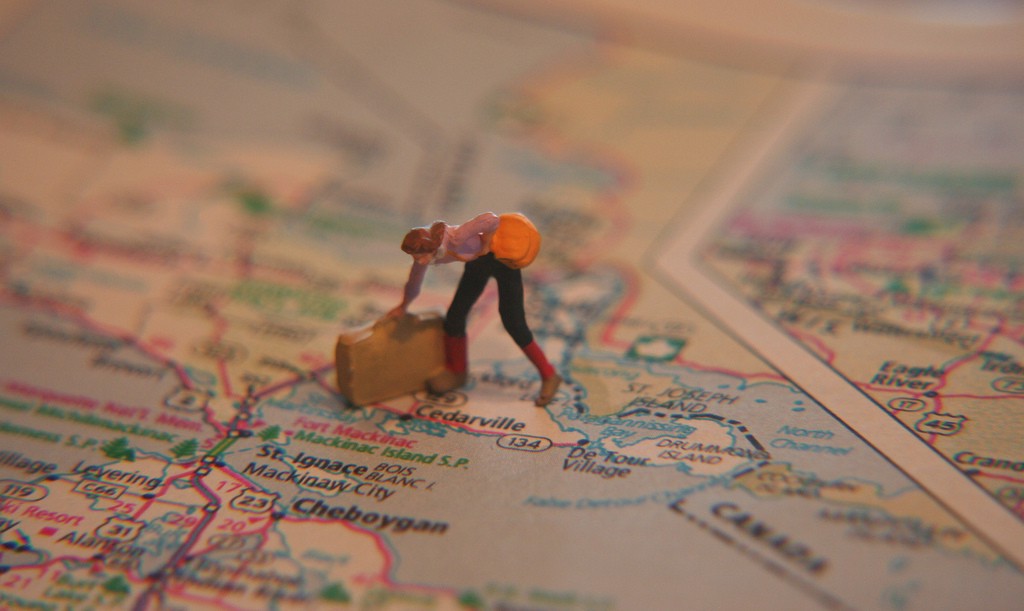How to Pack One Suitcase for a Long Trip
by Alison McConnell

You’re taking a big trip! Congratulations!
Whether you’re a careful planner of itineraries or more of a wanderer, packing smart pays dividends. You’ll avoid spending precious chunks of your budget on forgotten necessities. Plus, a well-packed suitcase makes flying much smoother in these checked-bag-fee-and-crammed-overhead-bin times.
After four trips of a month or longer in Europe, New Zealand and Australia, my battered Samsonite roll-aboard and I have a solid set of best practices for budget travel. Some of them come into play even before you roll up that first pair of socks to stuff into your shoes, so read on!
- Many discount airlines (such as Tigerair and Jetstar in Australia, or Ryanair in Europe) quote low base airfares, but charge additional fees for carry-on and checked baggage. Be sure to read the fine print and factor in those fees before buying a ticket. Sometimes a more expensive partner (Qantas, Virgin, British Airways) works out to be more cost-effective when you’re traveling with more than one bag.
- If your airline requires payment per kilo of baggage, always leave yourself some wiggle room. Some carriers charge usurious penalties for overweight bags on the day of travel, when you actually haul your suitcase onto the ticketing desk scale. At $5–10 per kilo, this can eat up cash in a blink. Some discount airlines weigh carry-ons, too. Plan and pay ahead; it’s always less expensive that way.
- Think through the activities on your itinerary, whether planned or hypothetical, and make yourself a master packing list. What will the weather be like? Will you need any special footwear? Is there anything you can’t live without, that you wear or use every single day? Do this at least a week before your departure, giving yourself plenty of time to remember everything you’ll need.
- Lay all of your clothing and gear out on one surface, neatly folded and grouped by type, at least a day before departure. Organizing before actual packing helps the process immensely.
- You always need less clothing than you think. I like to use the “three in, one out” rule — for every four items I place into my suitcase, one comes out and stays home. Double bonus if you’ve already sorted out places in your journey to do a quick load of laundry.
- When you zip up your bag to go, there should be 2–3 inches at the top for treasures. You’ll probably end up buying things, whether you’re a retail shopper, souvenir junkie or puruser of thrift stores. (Op-shopping, as the Aussies call it, is one of my favorite travel pastimes and a great way to return home with interesting secondhand finds.)
- I’ve traveled both with a large hiking pack and my rolling suitcase. Unless I’m backpacking — spending multiple days in the woods — I strongly prefer the ease and simplicity of access that comes with a rolling suitcase.
All right. So what actually goes in?
Below I’ve listed the items that filled my aforementioned Samsonite most recently, in April, when I got to spend four weeks Down Under. My trip was purely recreational and encompassed urban sightseeing in Sydney and Melbourne, hiking and camping in several national parks, a quick stint in Tasmania and several days’ bliss driving the aptly named Great Ocean Road.
I gathered, laid out and packed with the help of my master packing list, which changes a bit from trip to trip (climbing gear in, beach gear out, etc.) but stays very much the same otherwise. Weather is always being taken into account: South Australia cooled noticeably over the course of the month, from late summer into a chilly, wet fall, so rain gear was a must.
Here’s what I packed:
Clothes:
- Sleeveless shirts (5)
- Long-sleeved shirts (2)
- Half-zip fleece pullover
- Sweater
- Long skirt (1)
- Dresses (2)
- Yoga pants (2 pairs)
- Jeans (1 pair)
- Sports bras (3)
- Underwear (8 pairs)
- Athletic socks (3 pairs)
- Lightweight hiking socks (2 pairs)
- Super-warm thick socks (1 pair)
- Rain jacket and pants
- Wool hat
- Hiking boots
- Flip flops
- Sneakers (I wear New Balance Minimus MT20s, which are absolutely phenomenal for traveling — walking all day, running, light hiking … they can do it all)
Toiletries:
- Contact solution
- Toothbrush and toothpaste
- Makeup (foundation and mascara)
- Deodorant
- Razor
- Moisturizer with SPF 30
Electronics and gear:
- Books*
- Two US-Aus power adapters
- iPhone
- Headphones
- Camera, battery charger and USB cable
- Laptop and charger cable
- Nalgene water bottle
- Portable Bluetooth speaker
- Collapsible bowl and spork (for camping)
- A quick note about traveling with books: An electronic reader such as a Kindle is obviously a better choice for the old carry-on compared to physical books, which add weight no matter how fluffy the subject matter. (Fifty Shades, I’m looking at you.) Same goes for an iPad instead of a full-weight laptop. If you’re a book-toting dinosaur, don’t do what I’ve done (bring Atlas Shrugged to Central Europe and Infinite Jest to Australia), unless you’re actively trying to increase upper-body strength. A couple of light volumes is the way to go.
This story is part of our Travel Month series.
Alison L. McConnell is a writer based in upstate New York. She is a rabid advocate for pasture-raised bacon, the blues, locked carabiners, and the great state of Maine.
Photo: Kate Ter Haar
Support The Billfold
The Billfold continues to exist thanks to support from our readers. Help us continue to do our work by making a monthly pledge on Patreon or a one-time-only contribution through PayPal.
Comments